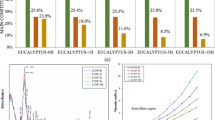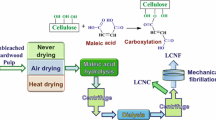Abstract
In this study, the effect of high residual lignin (21 % w/w) on the thermal properties of cellulose nanofibrils and the performance of films made from these nanofibrils in aqueous environments have been explored for the first time. Individualised cellulose nanofibrils with diameter <100 nm were obtained from the mechanical fibrillation of bark residue fibers with high lignin content. The mass loss by thermal degradation started at a higher temperature of 306 °C for these nanofibrils compared to 278 °C for those fibrils with low amount of lignin (5 % w/w). The maximum rate of degradation occurred at a temperature of around 390 and 319 °C for high and low lignin containing nanofibrils, respectively. Such a high thermal stability for high lignin containing nanofibrils has never been reported for nanocellulose from any other studies. The films made from these high lignin nanofibrils showed lower water uptake and better wet mechanical properties compared to films made from low lignin containing cellulose nanofibrils. The high lignin nanofibril films retained 38 % of the dry strength properties, while the low lignin nanofibril films were able to retain only 9 % of dry strength.







Similar content being viewed by others
References
Abraham E, Deepa B, Pothan LA, Jacob M, Thomas S, Cvelbar U, Anandjiwala R (2011) Extraction of nanocellulose fibrils from lignocellulosic fibres: a novel approach. Carbohydr Polym 86(4):1468–1475
Alemdar A, Sain M (2008) Isolation and characterization of nanofibers from agricultural residues—wheat straw and soy hulls. Bioresour Technol 99(6):1664–1671
Bjurhager I, Olsson AM, Zhang B, Gerber L, Kumar M, Berglund LA, Burgert I, Sundberg B, Salmen L (2010) Ultrastructure and mechanical properties of populus wood with reduced lignin content caused by transgenic down-regulation of cinnamate 4-hydroxylase. Biomacromolecules 11(9):2359–2365
Brebu M, Vasile C (2010) Thermal degradation of lignin—a review. Cellul Chem Technol 44(9):353–363
Browning BL (1967) Methods of wood chemistry, vol 2. Wiley, New York
Chancelier L, Diallo AO, Santini CC, Marlair G, Gutel T, Mailley S, Len C (2014) Targeting adequate thermal stability and fire safety in selecting ionic liquid-based electrolytes for energy storage. Phys Chem Chem Phys 16(5):1967–1976
Chen W, Yu H, Liu Y, Chen P, Zhang M, Hai Y (2011) Individualization of cellulose nanofibers from wood using high-intensity ultrasonication combined with chemical pretreatments. Carbohydr Polym 83(4):1804–1811
Dash R, Cateto CA, Ragauskas AJ (2014) Synthesis of a co-cross-linked nanocomposite hydrogels from poly (methyl vinyl ether-co-maleic acid)-polyethylene glycol and nanofibrillated cellulose. Cellulose 21(1):529–534
Effland MJ (1977) Modified procedure to determine acid-insoluble lignin in wood and pulp. Tappi 60(10):143–144
Ferrer A, Filpponen I, Rodriguez A, Laine J, Rojas OJ (2012a) Valorization of residual empty palm fruit bunch fibers (EPFBF) by microfluidization: production of nanofibrillated cellulose and EPFBF nanopaper. Bioresour Technol 125:249–255
Ferrer A, Quintana E, Filpponen I, Solala I, Vidal T, Rodriguez A, Laine J, Rojas OJ (2012b) Effect of residual lignin and heteropolysaccharides in nanofibrillar cellulose and nanopaper from wood fibers. Cellulose 19(6):2179–2193
Gousse C, Chanzy H, Cerrada ML, Fleury E (2004) Surface silylation of cellulose microfibrils: preparation and rheological properties. Polymer 45(5):1569–1575
Hoeger IC, Nair SS, Ragauskas AJ, Deng Y, Rojas OJ, Zhu JY (2013) Mechanical deconstruction of lignocellulose cell walls and their enzymatic saccharification. Cellulose 20(2):807–818
Hoeger I, Gleisner R, Negron J, Rojas OJ, Zhu JY (2014) Mountain pine beetle-killed lodgepole pine for the production of submicron lignocellulose fibrils. For Sci 60(3):502–511
Islam MT, Alam MM, Zoccola M (2013) Review on modification of nanocellulose for application in composites. Int J Innov Res Sci Eng Technol 2(10):5444–5451
Iwatake A, Nogi M, Yano H (2008) Cellulose nanofiber-reinforced polylactic acid. Compos Sci Technol 68(9):2103–2106
Jiang F, Hsieh YL (2013) Chemically and mechanically isolated nanocellulose and their self-assembled structures. Carbohydr Polym 95(1):32–40
Jiang F, Hsieh YL (2014) Super water absorbing and shape memory nanocellulose aerogels from TEMPO-oxidized cellulose nanofibrils via cyclic freezing–thawing. J Mater Chem A 2(2):350–359
Jin Z, Katsumata KS, Lam TBT, Iiyama K (2006) Covalent linkages between cellulose and lignin in cell walls of coniferous and nonconiferous woods. Biopolymers 83(2):103–110
Johar N, Ahmad I, Dufresne A (2012) Extraction, preparation and characterization of cellulose fibres and nanocrystals from rice husk. Ind Crops Prod 37(1):93–99
Koshijima T, Watanabe T (2003) Association between lignin and carbohydrates in wood and other plant tissues. Springer, Berlin, p 329
Kreze T, Strnad S, Stana-Kleinschek K, Ribitsch V (2001) Influence of aqueous medium on mechanical properties of conventional and new environmentally friendly regenerated cellulose fibers. Mater Res Innov 4:107–114
Kulachenko A, Denoyelle T, Galland S, Lindstrom SB (2012) Elastic properties of cellulose nanopaper. Cellulose 19(3):793–807
Lam TBT, Iiyama K (2000) Characteristics of senescent straw cell walls of dwarf, semi dwarf, and normal strains of rice (Oryza sativa) plants. J Wood Sci 46(5):376–380
Lee SH, Chang F, Inoue S, Endo T (2010) Increase in enzyme accessibility by generation of nanospace in cell wall supramolecular structure. Bioresour Technol 101(19):7218–7223
Li Y, Zhu H, Xu M, Zhuang Z, Xu M, Dai H (2014) High yield preparation method of thermally stable cellulose nanofibers. BioResources 9(2):1986–1997
Lonnberg H, Larsson K, Lindstrom T, Hult A, Malmstrom E (2011) Synthesis of polycaprolactone-grafted microfibrillated cellulose for use in novel bionanocomposites-Influence of the graft length on the mechanical properties. ACS Appl Mater Interfaces 3(5):1426–1433
Lu J, Askeland P, Drzal LT (2008) Surface modification of microfibrillated cellulose for epoxy composite applications. Polymer 49(5):1285–1296
Montano-Leyva B, Rodriguez-Felix F, Torres-Chavez P, Ramirez-Wong B, Lopez-Cervantes J, Sanchez-Machado D (2011) Preparation and characterization of durum wheat (triticum durum) straw cellulose nanofibers by electrospinning. J Agric Food Chem 59(3):870–875
Nair SS, Zhu JY, Deng Y, Ragauskas AJ (2014a) Hydrogels prepared from cross-linked nanofibrillated cellulose. ACS Sustain Chem. Eng 2(4):772–780
Nair SS, Zhu JY, Deng Y, Ragauskas AJ (2014b) Characterization of cellulose nanofibrillation by micro grinding. J Nanopart Res 16(4):2349
Osong SH, Norgren S, Engstrand P (2013) An approach to produce nano-ligno-cellulose from mechanical pulp fine materials. Nord Pulp Pap Res J 28(4):472–479
Paakko M, Vapaavuori J, Silvennoinen R, Kosonen H, Ankerfors M, Lindstrom T, Berglund LA, Ikkala O (2008) Long and entangled native cellulose I nanofibers allow flexible aerogels and hierarchically porous templates for functionalities. Soft Matter 4(12):2492–2499
Pejic BM, Kostic MM, Skundric PD, Praskalo JZ (2008) The effects of hemicelluloses and lignin removal on water uptake behavior of hemp fibers. Bioresour Technol 99(15):7152–7159
Poletto M, Zattera AJ, Forte MMC, Santana RMC (2012) Thermal decomposition of wood: influence of wood components and cellulose crystallite size. Bioresour Technol 109:148–153
Poletto M, Ornaghi HL, Zattera AJ (2014) Native cellulose: structure, characterization and thermal properties. Materials 7(9):6105–6119
Quievy N, Jacquet N, Sclavons M, Deroanne C, Paquot M, Devaux J (2010) Influence of homogenization and drying on the thermal stability of microfibrillated cellulose. Polym Degrad Stab 95(3):306–314
Ramadevi P, Sampathkumar D, Srinivasa CV, Bennehalli B (2012) Effect of alkali treatment on water absorption of single cellulosic abaca fiber. BioResources 7(3):3515–3524
Rodionova G, Lenes M, Eriksen O, Gregersen O (2011) Surface chemical modification of microfibrillated cellulose: improvement of barrier properties for packaging applications. Cellulose 18(1):127–134
Rojo E, Peresin MS, Sampson WW, Hoeger IC, Vartiainen J, Laine J, Rojas OJ (2015) Comprehensive elucidation of the effect of residual lignin on the physical, barrier, mechanical and surface properties of nanocellulose films. Green Chem 17(3):1853–1866
Sharma S, Zhang X, Nair SS, Ragauskas A, Zhu JY, Deng Y (2014) Thermally enhanced high performance cellulose nano fibril barrier membranes. RSC Adv 4(85):45136–45142
Spence KL, Venditti RA, Rojas OJ, Habibi Y, Pawlak JJ (2010) The effect of chemical composition on microfibrillar cellulose films from wood pulps: water interactions and physical properties for packaging applications. Cellulose 17(4):835–848
Spoljaric S, Salminen A, Luong ND, Seppala J (2013) Crosslinked nanofibrillated cellulose: poly (acrylic acid) nanocomposite films; enhanced mechanical performance in aqueous environments. Cellulose 20(6):2991–3005
Van Valkenburg ME, Vaughn RL, Williams M, Wilkes JS (2005) Thermochemistry of ionic liquid heat-transfer fluids. Thermochim Acta 425:181–188
Wang QQ, Zhu JY, Gleisner R, Kuster TA, Baxa U, McNeil SE (2012) Morphological development of cellulose fibrils of a bleached eucalyptus pulp by mechanical fibrillation. Cellulose 19(5):1631–1643
Wise LE, Murphy M, D’Addieco AA (1946) Chlorite holocellulose, its fractionation and bearing on summative wood analysis and studies on the hemicelluloses. Pap Tr J 122(2):35–43
Acknowledgments
Authors would like to acknowledge the financial support from Ontario Research Fund-Research Excellence program-Bark Biorefinery project partners and NSERC Innovative Green Wood Fiber Products Network.
Author information
Authors and Affiliations
Corresponding author
Electronic supplementary material
Below is the link to the electronic supplementary material.
Rights and permissions
About this article
Cite this article
Nair, S.S., Yan, N. Effect of high residual lignin on the thermal stability of nanofibrils and its enhanced mechanical performance in aqueous environments. Cellulose 22, 3137–3150 (2015). https://doi.org/10.1007/s10570-015-0737-5
Received:
Accepted:
Published:
Issue Date:
DOI: https://doi.org/10.1007/s10570-015-0737-5




